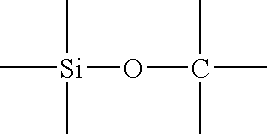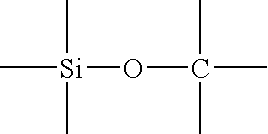Open-cell polyurethane foam and process for its manufacture
a polyurethane foam and open-cell technology, applied in the field of open-cell polyurethane foams, can solve the problems of destabilizing the foam, forming hydrogels, and dimensional distortion in closed-cell foams
- Summary
- Abstract
- Description
- Claims
- Application Information
AI Technical Summary
Benefits of technology
Problems solved by technology
Method used
Image
Examples
examples
[0065]In accordance with generally accepted usage, the following symbols are used to describe the polyether-polysiloxane copolymer surfactants used in making the polyurethane foams (both within and outside the scope of the claims, the latter for comparison purposes) of the examples:
[0066]M refers to (CH3)3SiO1 / 2;
[0067]M′ refers to (H)(CH3)2SiO1 / 2 (terminal hydrogen);
[0068]M″ refers to (X)(CH3)2SiO1 / 2 in which X is, e.g., methoxy, ethoxy, dimethylamino, hydrogen, halogen or other leaving group (X will undergo reaction with the hydroxyl group of a polyether monol to form a polysiloxane-polyether copolymer possessing a hydrolyzable
bond while releasing HX);
[0069]D refers to (CH3)2SiO2 / 2;
[0070]D′ refers to (H)(CH3)SiO2 / 2 (pendant hydrogen providing comb-type silicone-polyether copolymer upon reaction with olefinically unsaturated polyether); and,
[0071]″ refers to (R)(CH3)SiO2 / 2 where R is a polyether-containing group.
[0072]The polyethers used in making the surfactants employed in the exa...
PUM
| Property | Measurement | Unit |
|---|---|---|
| mole ratio | aaaaa | aaaaa |
| temperature | aaaaa | aaaaa |
| shrinkage | aaaaa | aaaaa |
Abstract
Description
Claims
Application Information
 Login to View More
Login to View More - R&D
- Intellectual Property
- Life Sciences
- Materials
- Tech Scout
- Unparalleled Data Quality
- Higher Quality Content
- 60% Fewer Hallucinations
Browse by: Latest US Patents, China's latest patents, Technical Efficacy Thesaurus, Application Domain, Technology Topic, Popular Technical Reports.
© 2025 PatSnap. All rights reserved.Legal|Privacy policy|Modern Slavery Act Transparency Statement|Sitemap|About US| Contact US: help@patsnap.com



